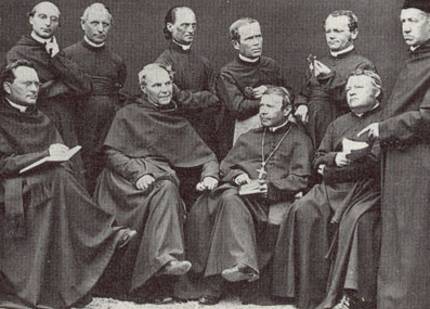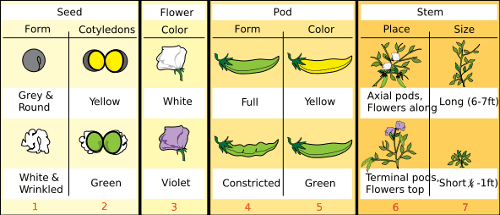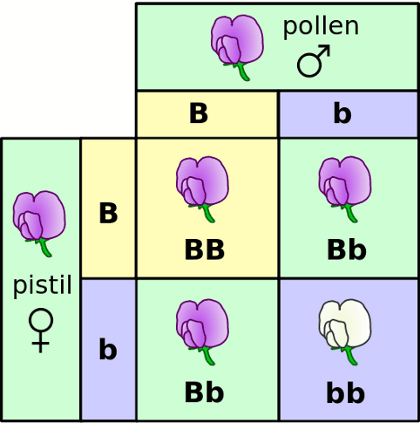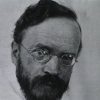Gregor Mendel is the father of genetics. He:
• Founded the science of genetics.
• Identified many of the rules of heredity. These rules determine how traits are passed through generations of living things.
• Saw that living things pass traits to the next generation by something which remains unchanged in successive generations of an organism – we now call this ‘something’ genes.
• Realized that traits could skip a generation – seemingly lost traits could appear again in another generation – he called these recessive traits.
• Identified recessive and dominant traits which pass from parents to offspring.
• Established, momentously, that traits pass from parents to their offspring in a mathematically predictable way.
Mendel’s work only made a big impact in 1900, 16 years after his death, and 34 years after he first published it.
Mendel’s Education and the Abbey of St. Thomas
Johann Mendel (he wasn’t called Gregor until later) was born July 20, 1822, in Heinzendorf bei Odrau. This small village was in the Austrian Empire, but is now in the Czech Republic.
Mendel’s parents were small farmers who made financial sacrifices to pay for his education.
He did well enough at high school to make it, aged 18, to the University of Olomouc in 1840. The university was about 40 miles (60 km) from his home village. He took courses in physics, mathematics and philosophy.
You want to keep doing science? You need to be a monk!
In 1843, aged 21, and in financial difficulty, one of his teachers, Professor Friedrich Franz, a physicist, advised Mendel to join the Abbey of St. Thomas in Brünn as a monk.
The Abbey actually had a good reputation for its teaching of sciences, and its director, Abbot Franz Cyril Napp, was particularly interested in heredity of traits in plants and animals on farms.
If he could join the Abbey, he could continue studying science, while ensuring he could get by financially. And so Mendel, who was more interested in science than religion, became a monk.
The move to Brünn carried him much farther away from his home village. On joining the Abbey, he took the name Gregor. From then on he ceased to be Johann Mendel and became Gregor Mendel.
Learning and Teaching Science
In 1846, aged 24, Mendel took fruit-growing classes given by Professor Franz Diebl at the Brünn Philosophical Institute. Diebl was an authority on plant breeding.
Mendel became a priest in 1847 and got his own parish in 1848. He did not enjoy working as a parish priest and got a job as a high school teacher in 1849.
In 1850, aged 28, he failed exams which would have qualified him as a high school teacher.
A year later, he went to the University of Vienna where he studied chemistry, biology and physics. The idea was that by strengthening his knowledge in these subjects, he could qualify as a high school teacher.
Two years later, after completing his studies, he returned to the monastery in 1854 and took a position as a physics teacher at a school at Brünn, where he taught for the next 16 years.
Research and Admin
In 1856, aged 34, he again failed to qualify formally as a high school teacher. This time, illness prevented him completing the exams.
In the same year, he began his major, groundbreaking study of heredity in plants.
In 1865, still interested in physical science, he founded the Austrian Meteorological Society. In fact, during his life, Mendel published more about meteorology than he did biology!
In 1866, he published his heredity work. Unfortunately, most people who read it did not recognize the intellectual gold that his paper contained.
In 1867, aged 45, he became Abbot of his monastery and devoted himself to its smooth running as its administrator.

At the monastery in Brünn in the early 1860s. Mendel is pictured back right, looking at part of a plant in his left hand. Abbot Franz Cyril Napp sits in the front row, wearing a large cross. Abbot Napp encouraged Mendel’s science and heredity studies.
Mendel and Genetics: Experiments with Peas: 1856 to 1863
During his time in Olomouc, Mendel had made friends with two university professors: Friedrich Franz, a physicist, and Johann Karl Nestler, an agricultural biologist, who was interested in heredity.
Nestler passed his interest in heredity to Mendel, who was intrigued by the subject.
Mendel’s monastery had a 5 acre (2 hectare) garden, and his two former professors encouraged Mendel to pursue his interest in heredity by using the garden for experiments.
Abbot Franz Cyril Napp and Professor Franz Diebl also encouraged him to follow this path.
Mendel was unhappy with how inheritance of traits was being explained
People had known for millennia about selective breeding. They knew that by breeding from those individuals that showed the most desirable traits, future generations were more likely to show these desirable traits.
- Guard dogs might be bred from parents that were loyal and friendly to their owners, but were suspicious or even aggressive with strangers.
- Cattle might be bred from cows that yielded most milk and bulls that yielded most meat.
- Wheat might be kept and sown the following year from those plants which had produced the most abundant crop.
The main theory of heredity in Mendel’s time was that offspring were a smooth blend of their two parents’ traits.
Mendel set himself the very ambitious task of discovering the laws of heredity.
To achieve this, he embarked on a mammoth sized, highly systematic, eight year study of edible peas, individually and carefully recording the traits shown by every plant in successive generations.
His work involved growing and recording the traits in about 30,000 plants.
One of the keys to his success was breeding from closely related pea varieties which would differ in only a small number of traits.

The seven traits of pea plants that Mendel chose to study: seed wrinkles; seed color; seed-coat color, which leads to flower color; pod shape; pod color; flower location; and plant height. Image by Mariana Ruiz.
Mendel’s Results for Flower Color
Mendel found the same results for all traits, but we’ll look at flower color as an example.
When Mendel bred purple-flowered peas (BB) with white-flowered peas (bb), every plant in the next generation had only purple flowers (Bb).
When these purple-flowered plants (Bb) were bred with one-another to create a second-generation of plants, some white flowered plants appeared again (bb).
Mendel realized that his purple-flowered plants still held instructions for making white flowers somewhere inside them.
He also found that the number of purple to white was predictable.
75 percent of the second-generation of plants had purple flowers, while 25 percent had white flowers. He called the purple trait dominant and the white traitrecessive.

A Punnett Square. Both of the starting plants have purple flowers but they contain the genes for purple (B) and white (b). The pollen from the male plant fertilizes the egg in the female flower. In this variety of plant, purple flowers are caused by a dominant gene (B). Dominance is indicated by a capital letter. White flowers are caused by recessive genes, indicated by the small letter (b). Both the male and female parent plants in the diagram above carry the dominant gene B for purple and the recessive gene b for white flowers. The ratio of purple flowers to white flowers in their offspring will be 3:1 as shown in this diagram. For a white flower to appear, the offspring must inherit the recessive gene from both parents. Purple appears with any other combination of genes inherited from the parent plants. Image by Madeleine Price Ball
Mendel’s Conclusions
Mendel’s most important conclusions were:
- The inheritance of each trait is determined by something (which we now call genes) passed from parent to offspring unchanged. In other words, genes from parents do not ‘blend’ in the offspring.
- For each trait, an organism inherits one gene from each parent.
- Although a trait may not appear in an individual, the gene that can cause the trait is still there, so the trait can appear again in a future generation.
Scientists who did research later found that Mendel’s results do not only apply to pea plants. Trait inheritance in most plants and animals, including humans, follows the patterns Mendel recorded.
In Mendel’s honor, these very common patterns of heredity are now calledMendelian Inheritance.
Fast Forward to 1900: The Sleeping Giant Awakes
In 1900, three scientists independently carrying out heredity research got exciting results.
However, when they searched the literature, they realized their results were not really new. Their results actually verified the forgotten results Mendel had published 34 years earlier.
Mendel’s results gave the scientists of 1900 greater confidence in their own results and the new science of genetics was truly born.
The scientists were Carl Correns, Hugo de Vries, and Erich von Tschermak.
 “I thought that I had found something new. But then I convinced myself that the Abbot Gregor Mendel in Brünn, had, during the sixties, not only obtained the same result through extensive experiments with peas, which lasted for many years, as did de Vries and I, but had also given exactly the same explanation, as far as that was possible in 1866.”
“I thought that I had found something new. But then I convinced myself that the Abbot Gregor Mendel in Brünn, had, during the sixties, not only obtained the same result through extensive experiments with peas, which lasted for many years, as did de Vries and I, but had also given exactly the same explanation, as far as that was possible in 1866.”
CARL ERICH CORRENS, 1864 TO 1933
Geneticist and Botanist
Mendel’s Results Were “Too Good”
Mendel’s published work was rather vague about detailed experimental procedures, including dates.
Enter Ronald Fisher, a very eminent geneticist and statistician. It was Fisher who first used the term ‘null hypothesis’ in statistical testing.
In 1936, Fisher tried to reconstruct on paper the way Mendel carried out his experiments.
He also wanted to discover why Mendel’s work had been overlooked for so long until it was rediscovered in 1900.
He found that, although some people in a position to see the importance of Mendel’s work had actually read it, they did not realize its importance. Their minds were unreceptive to Mendel’s words and ideas. They may have believed he was repeating plant hybridization work others had already carried out.
Controversially, Fisher said that his statistical analysis of Mendel’s results showed too few random errors to have come from real experiments. Nearly all of Mendel’s data showed an unnatural bias.
Fischer wrote:
 “Although no explanation can be expected to be satisfactory, it remains a possibility among others that Mendel was deceived by some assistant who knew too well what was expected. This possibility is supported by independent evidence that the data of most, if not all, of the experiments have been falsified so as to agree closely with Mendel’s expectations.”
“Although no explanation can be expected to be satisfactory, it remains a possibility among others that Mendel was deceived by some assistant who knew too well what was expected. This possibility is supported by independent evidence that the data of most, if not all, of the experiments have been falsified so as to agree closely with Mendel’s expectations.”
RONALD FISHER, 1890 TO 1962
Statistician, Geneticist, Evolutionary Biologist
Fisher’s analysis said there was only a 1 in 2000 chance that Mendel’s results were the fully reported results of real experiments.
The controversy begun by Fisher continues to this day, with a steady stream of publications seeking to give reasons for Mendel’s results. One possibility is that results from ‘bad’ experiments were discarded to leave only the results of ‘good’ experiments. Another is that the results arose from an unconscious bias on the part of the experimenters.
The End
Gregor Mendel was unaware of the new science of genetics which he had founded, and unaware of any future controversies. He died of a kidney disease, aged 61, on January 6, 1884.

No comments:
Post a Comment